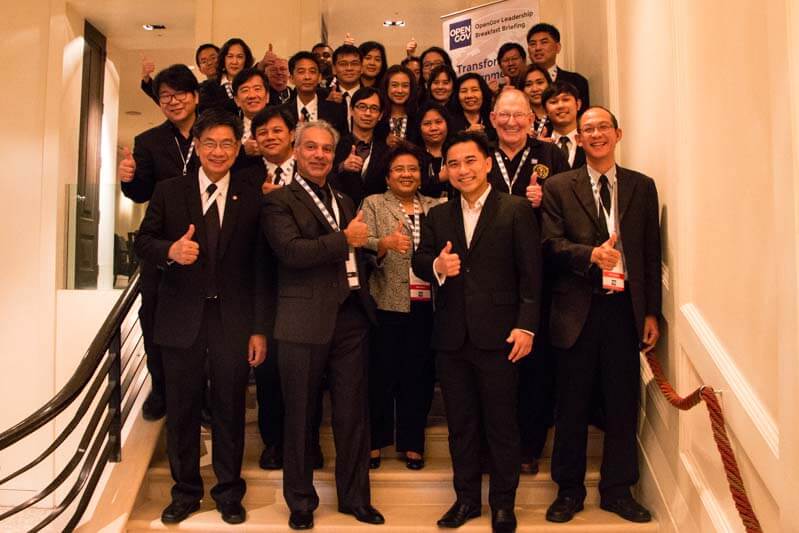
The third OpenGov Leadership Breakfast Dialogue on ‘Transforming government with flexibility and transparency: Doing more with less’ was held in Bangkok, following successful sessions in Kuala Lumpur and Jakarta.
Damien Wong (below left), Vice-president and General Manager, ASEAN for Red Hat talked change in technology. He talked about how virtualisation is an example of a traditional legacy technology. You virtualise your 3-tier applications. But the new type of cloud-based applications run on server-less computing.
You need open stack, you need containers to power these type of applications. There is a need to evolve and embrace the new technologies that are coming our way. Most innovation these days is driven by the open source community. Whether it is cloud computing, you see open stack, software-defined storage. Devops approach is also based on open source. Proprietary is no longer the de facto way of innovation.

Innovation is no longer driven by vendors. It is driven by the big users. Whether it is Facebook, Google. They don’t just consume IT in the open source world. They also actively participate and contribute. If you look at the hundreds and thousands of engineers that are participating, no one company can be bigger than that.
There are concerns about reliability, performance, stability and so on. That’s where Red Hat comes into play. They make open source enterprise-ready. If you are a bank or a telco or a government agency, you don’t want to run potentially unstable software.
In the final part of his presentation, Mr. Wong talked about Thailand 4.0, the government policy to transition Thailand into an inclusive, sustainable, high-income digital economy. It has to be ensured that all stakeholders are brought along in the process of digital transformation takes place, the consumers of the services, the providers of the technology as well as the policy creators.
Open Source drives digital transformation and Red Hat makes open source consumable for organisations.
Klaus Felsche (below left), Former Director of Analytics from the Department of Immigration and Border Protection in Australia shared the lessons he learnt building an advanced analytics system for assessing visa and traveller risk in less than half a second. The first version was built in less than 18 months starting from scratch.
In one internet minute, there are 2.4 million search queries on Google, 150 million emails are sent, over 700,00 logins on Facebook and 2.8 million videos are viewed on Youtube. You add IoT devices. And there is a veritable flood of data.
There is so much data in the world that we find it difficult to get value from it. He cited a statistic saying only 0.5% of data is ever analysed. If we can increase that to 1%, our effectiveness is doubled. Finding ways to use the data would also help attract and retain talent. Governments have access to unmatched quality of data. Providing access to it would attract the best minds.
Using open source might be the best way to develop tools to do so. You can start small, experiment, iterate, fail without high costs and get rid of the bad ideas. Open Source provides the perfect platform for such a process.

Mr. Felsche provided the example of Kaggle, where statisticians and data scientists from around the world compete to produce the best analytics models. In one competition 316 teams from around the world created 189 scripts over a period of one week. No one company can match that scale or the range of that brain power. And it is free.
Enterprise open source might not be free. But it is still economical, powerful and capable of driving innovation. It avoids lock-in. It provides the freedom to explore and move when technology changes. Instead of tying yourself to a specific vendor and paying through the nose for upgrades, as and when the vendor decides.
Questions and discussion
There was near even split in delegate responses, when asked about their understanding of open source, with 46% saying that they had a good understanding and 46% replying they would like to know more. It was very similar to the response at the dialogue in Malaysia, where 48% and 52% respectively chose the aforementioned options.
Mr. Wong provided further details on open source. He contrasted it with proprietary, closed-source innovation. Closed means you don’t see the code. Protecting source code was considered more important. Nearly 99% of organisations today are using open source in some form or the other, even if they do not know it.
He also clarified that agencies do not need a surfeit of open source experts to adopt open source. It is adopted by agencies and organisations for a variety of reasons, ranging from speed (stock exchanges) and cost-effectiveness to security (military).
He gave the example of the myResponder app in Singapore, available on the App Store and the Play Store. It relies on a voluntary community initiative to get rapid assistance to victims of out-of-hospital cardiac arrest. Based on a collaboration between Singapore Civil Defence Force and Infocomm Development Authority of Singapore, the app took virtually no money and a week to develop.
This is the kind of innovation which can be enabled by open source. 1 or 3 year plans are no longer a viable approach to technology adoption. What’s required is Agile methodology and agile and open source are a perfect fit for each other.
Around 44% of attendees rated their organisation’s digital capabilities at par with their peers in the public, healthcare and education sectors, while 48% thought they were ahead of the curve.
Charin Thiratitayangkul, Vice President Policy and Strategy Department, Electronic Government Agency (EGA) talked about his agency’s mandate to drive digital transformation across the public sector. Hence, the necessity for them to stay ahead.
Jedsada Ariyachatkul, Director Information and Communication Technology Bureau from The Customs Department spoke about their department’s transition to a paperless system.
During the subsequent discussion, everyone concurred that for an agency to be ahead, it needs leadership and long-term vision, along with operational capabilities.

Bob Morris (above), Advisor to Director, Banphaeo Hospital brought up two restrictions hindering adoption of open source in public sector organisations, government policy and culture. He said that the second one was by far the more crucial barrier to overcome. To get past that, it would be essential for the ICT experts to assume leadership role in their organisations and educate the board and staff about innovation and open source, opening their eyes, ears and minds.
Mr. Morris gave the example of Banpaheo Hospital. When they became a public organisation, the number of walk-ins without appointments spiked from 800-900 a day to over 5000 a day. A paper-based system would have been unmanageable. The hospital has implemented an integrated system, managing medical records, personal information, payment capabilities, demographics of where they work, payment capabilities and all other details, using an open source database. Their IT budget was reduced by 50%. Today they are quite capable of handling an additional 3000-4000 walk-in patients, with minimal new expenditure. This scalability is a key advantage of open source.
The delegates were asked what is the top barrier that impedes them from taking advantage of digital trends. Nearly 33% opted for ‘lack of an overall strategy’. This was in sharp contrast to Malaysia and Indonesia, where only 9% and 10% respectively selected that option. Some of the respondents said they would have picked ‘all of the above’ if that option had been provided.
The remaining votes were split between ‘too many competing priorities’, ‘Insufficient funding’ and ‘security concerns’ with the options garnering 21%, 25% and 13% of votes respectively. Insufficient funding had been chosen as the primary barrier in both Malaysia (68%) and Indonesia (41%).
Security becomes a key concern in the case of data-driven projects, where it is essential to safeguard citizens’ data, while using it to improve government services.
Wannasiri Bhuasiri, Chief Technology Officer, from the Office of National Digital Economy and Society Commission talked about the broad scope of their agency. They have to work with multiple ministries and agencies, balancing an exceptionally wide range of requirements.

Limited available resources frequently end up getting directed to keeping the lights on. This stifles innovation. The challenge is to think about and spend on the future, while maintaining day-to-day operations. Also, many agencies have a strategy. They need to learn how to implement the strategy.
For 70% of the agencies, investment in digital initiatives had increased significantly this fiscal year compared to the last. This was the highest among three countries including Malaysia (67%) and Indonesia (45%). This was in line with the Thai government’s adoption of the Digital Thailand plan earlier this year.
Nearly 76% of delegates said that their organisation has a clear and coherent digital strategy (91% in Malaysia and 78% in Indonesia). Among the ones who responded positively, Waiboon Chanchio, Assistant Governor / Chief Information Officer at the Electricity Generating Authority of Thailand talked about adopting a comprehensive strategy aligning their business and digital plans.
Asst. Prof Dr. Mongkol Pusayatanont, Director Computer and Networking, Ubon Ratchathani University spoke about the relatively faster pace of technology adoption in education compared to the public sector. He also brought up the necessity of aligning education with industry developments.

The attendees were asked whether they have the IT skills to implement digital strategies. 48% said they have in-house skills, while 26% each selected upgrading skills and outsourcing. The consensus was that usually a mix would be required. In-house staff have to be trained, and outside help must be brought in when required.
Customer/ citizen demands came up as the biggest driver of digital transformation at 55% of votes (75% and 67% in Malaysia and Indonesia respectively). However, government directives received 40%, much higher than the number around 10% in the previous two countries. The process is being kick-started top down by the government. Gradually, citizen-focus should become the primary driver.
This was reflected in the next question. Around a quarter of the delegates replied that they had a high level of involvement in creating digital services, and 60% said citizen involvement was at a medium level. The ‘high’ option obtained nearly 50% votes in the previous two polls in Malaysia and Indonesia.
Mr. Morris highlighted the fact that certain sections of citizens/ consumers might not be aware of what the digital world can offer them and hence, might have limited ability to participate in the process. Huge dividends could be reaped by educating them.
Mohit Sagar, Editor-in-chief, OpenGov concluded talking about sharing and collaboration. He exhorted the agency representatives to share knowledge and information among themselves and with their counterparts from other countries and governments. Mr. Felsche added that learning best practices from the private sector is also important. Because re-inventing the wheel is a waste of time and resources. That time and those resources could be directed towards designing more efficient and intuitive services and improving citizens’ lives.
Currently, 48% of representatives said they are using open source to a moderate extent to deliver services. An improvement in that number could play an important role in enabling the broad strategy of the government in Thailand. Things are changing so fast, that no single person or organisation can predict the future. Open source provides the platform for everybody to come together and create the future.
















